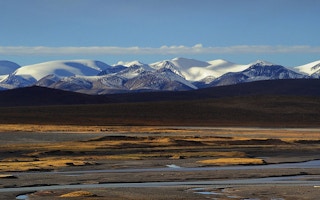The retreat of mountain glaciers nearly everywhere in the world over the last century can be put down to climate change. And scientists now think that they can say so with between 90 per cent and 99 per cent certainty in almost all cases.
They do so as a second research team analyse a set of devastating glacial collapses in Western Tibet – catastrophic events that killed at least nine herdsmen and sent 70 million cubic metres of ice hurtling down the mountainside to bury more than six kilometres of valley floor.
Researchers have been warning for years that glaciers are in retreat in both hemispheres and on all the great continents.
Local landscapes and climates
But attributing a cause has been tentative. Every glacier is a unique product of local climate and landscape. Each responds very slowly to changes in local climate, and there are variations from year to year. So one glacier is, on its own, a blunt statistical instrument, US and European scientists report in Nature Geoscience.
It isn’t easy to say why a glacier might retreat, or whether that retreat is a product of global warming. But a team led by Gerard Roe of the University of Washington in Seattle has found a way to look at the big picture.
The scientists studied the pattern of behaviour of 37 glaciers spread around the globe, in Austria, in Washington State in the US, in New Zealand, in Sweden and so on, and matched them with local meteorological trends.
“
Even though the scientific analysis arguably hasn’t always been there, it now turns out that it really is true – we can look at glaciers all around us that we see retreating, and see definitive evidence that the climate is changing.
Gerard Roe, University of Washington in Seattle
Ideally, researchers would like to know about the changes in the mass of ice in a glacier, but measurements of these don’t stretch very far back. But the retreat of the world’s glaciers – their terminals now compared with where they ended many decades ago – is well documented in paintings, photographs and alpine records.
Professor Roe and his colleagues say “the centennial-scale retreat of the local glaciers does indeed constitute categorical evidence of climate change”.
In other words, glacial retreat is one of the purest signals of climate change yet measured by statistical techniques: it could be seen at work in 36 of the 37 cases.
“We evaluate glaciers that are hanging on at high altitudes in the deserts of Asia, as well as glaciers being beaten up by mid-latitude storms in maritime climate settings.
The thickness, slope and area of the glaciers are different, and all of those things affect the size of the glacier length fluctuations,” Professor Roe says.
Glacier collapse
“Even though the scientific analysis arguably hasn’t always been there, it now turns out that it really is true – we can look at glaciers all around us that we see retreating, and see definitive evidence that the climate is changing,” he says.
“That’s why people have noticed it. These glaciers are stunningly far away from where they would have been in a pre-industrial climate.”
Meanwhile, in the Journal of Glaciology, Chinese scientists and a US colleague have been studying two Tibetan glacier collapses that, they say, are unprecedented. In this case, the scientists are more concerned with understanding the collapse than ascribing a cause.
The two glaciers are in the remotest parts of Tibet, and unusually heavy snowfalls may have had a role. But meltwater, too, may have played a part in the sudden, lethal slide of ice.
“It is all too easy to blame global warming for events such as these, but we know the temperature at the nearest weather station has risen by 1.5°C in the past 50 years,” said Lonnie Thompson of Ohio State University’s School of Earth Sciences, one of the authors.
“The warming may have raised previously frozen glacier beds to the melting point. If our thinking is along the right lines, there is no obvious reason why other frozen-bed glaciers in the area, or elsewhere for that matter, should not collapse. As of today, unfortunately, we have no ability to predict such disasters.”
This story was published with permission from Climate News Network.










